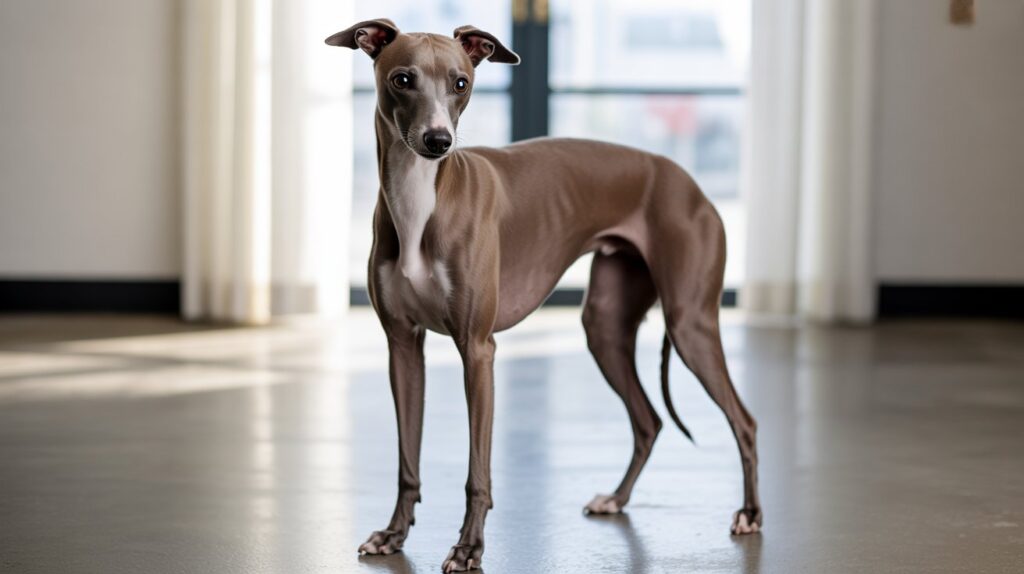Table of Contents
- An Introduction to the Elegant Italian Greyhound
- The Science Behind the Sleek: Why the Italian Greyhound’s Coat is so Thin
- A Legacy of Speed
- Minimalist by Design
- The Solar-Powered Sighthound: An Obsession with Sunbathing
- Why They Seek the Sun
- The Hidden Dangers of Sun Worship
- Essential Care for Your Delicate Companion
- Mastering Temperature Control
- The IG Wardrobe: More Than a Fashion Statement
- Skin and Coat Health
- Conclusion: Embracing Their Unique Needs
- Frequently Asked Questions (FAQs)
An Introduction to the Elegant Italian Greyhound
Picture this: a sliver of sunlight pierces through the window, creating a perfect, warm rectangle on the floor. In the centre of that golden patch, you’ll likely find an Italian Greyhound, contorted into an impossibly comfortable-looking position, soaking up every last ray. This quintessential image captures the very essence of the breed. Known for their delicate frames, graceful movement, and deeply affectionate nature, Italian Greyhounds (or “IGs”) are sighthounds in miniature. But their most defining physical characteristic—a short, thin coat—is both a hallmark of their elegance and the source of their most specific care requirements. This guide delves into why these dogs are built this way, their famous love for sunbathing, and how to provide the best possible care for their unique needs.

The Science Behind the Sleek: Why the Italian Greyhound’s Coat is so Thin
An Italian Greyhound’s coat isn’t an accident of fashion; it’s a direct result of its purpose-bred history and physiology. Understanding the “why” behind their single layer of fur is key to understanding their needs.
A Legacy of Speed
As sighthounds, Italian Greyhounds were bred for explosive bursts of speed to chase small game. Every aspect of their anatomy is fine-tuned for aerodynamic efficiency:
- Deep Chest: To house large, powerful lungs.
- Flexible Spine: For a “double-suspension gallop.”
- Lightweight Frame: To maximize speed and agility.
A thick, double coat would create drag and add unnecessary weight, hindering their primary function. Their sleek, skin-tight coat is the canine equivalent of a sprinter’s uniform.
Minimalist by Design
Beyond speed, these dogs lack the features many other breeds use to stay warm. They possess a single coat of fur with no insulating undercoat and an extremely low body fat percentage, often less than 10. This combination means they have virtually no natural defence against the cold. Their thin skin, stretched over a bony physique, leaves them vulnerable to temperature fluctuations that other dogs would barely notice.
The Solar-Powered Sighthound: An Obsession with Sunbathing
If sunbathing were an Olympic sport, the Italian Greyhound would be a perennial gold medalist. Their desire to find the warmest spot in any room is a legendary and endearing quirk of the breed.
Why They Seek the Sun
This behaviour is pure instinct. Lacking natural insulation, Italian Greyhounds are masters of thermal regulation through external means. They are essentially “solar-powered,” using the sun’s warmth to raise their body temperature to a comfortable level. A sunbeam is their personal, free-of-charge heating pad. It’s a simple and effective way for them to counteract their natural predisposition to feeling chilly.
The Hidden Dangers of Sun Worship
While their love for the sun is natural, it’s not without risks. Their thin coat and often pale, exposed skin make them highly susceptible to the sun’s harmful effects.
- Sunburn: Just like humans, IGs can get sunburned. Areas with little to no fur, such as the belly, nose, and ears, are particularly vulnerable. Repeated sun damage can lead to skin cancer.
- Heatstroke: Despite seeking warmth, they can easily overheat, especially during hot summer days. As they lie in direct sun, their body temperature can rise to dangerous levels, leading to heatstroke, which is a medical emergency.
It’s crucial for owners to monitor their sunbathing sessions, provide shady alternatives, and never leave them unattended outdoors in the heat.
Essential Care for Your Delicate Companion
Owning an Italian Greyhound means becoming an expert in managing their environment and comfort. Their care routine revolves almost entirely around their thin coat and sensitivity.
Mastering Temperature Control
Your primary role is that of a thermostat. An IG will be cold in temperatures that feel perfectly comfortable to you. A general rule of thumb is if you need a light jumper, they likely need a warm coat. Environments with temperatures below $15^\\circ C$ ($60^\\circ F$) can quickly become uncomfortable and even dangerous for them, potentially leading to hypothermia. They will shiver, tuck their legs, and seek out blankets or your lap for warmth.
The IG Wardrobe: More Than a Fashion Statement
For an Italian Greyhound, clothing is not a cute accessory; it is essential equipment. A well-stocked wardrobe is a necessity for year-round comfort. Key items include:
- Fleece Jumpers & Pyjamas: Perfect for indoor lounging, chilly mornings, and sleeping on cold nights.
- Warm Winter Coats: A waterproof and windproof outer layer with a thick fleece or quilted lining is vital for walks in the cold.
- Raincoats: Their thin fur becomes saturated almost instantly, chilling them to the bone. A simple raincoat keeps them dry and makes wet-weather walks tolerable.
Skin and Coat Health
While they are low-shedding and require minimal grooming, their skin needs attention.
- Bathing: Use gentle, moisturizing, hypoallergenic dog shampoos to avoid drying out their sensitive skin.
- Moisturizing: A light application of coconut oil can help soothe dry patches.
- Sun Protection: For extended time outdoors, consult your vet about a pet-safe sunscreen to apply to vulnerable areas.
- Regular Checks: Because their coat offers little protection, they are prone to nicks, scrapes, and scratches. Regularly check their skin for any injuries, especially after a run in a wooded area.
Conclusion: Embracing Their Unique Needs
The Italian Greyhound’s thin coat is a beautiful feature that speaks to its noble, athletic heritage. However, this elegance comes with a responsibility for the owner. Providing warmth, protection from the elements, and a safe sunbathing environment are not optional extras but fundamental pillars of their care. By understanding and embracing these unique needs, you provide the foundation for a healthy, happy life with your delicate, sun-worshipping companion, strengthening the incredible bond you share.
Frequently Asked Questions (FAQs)
1. Do Italian Greyhounds get cold easily? Yes, extremely easily. Due to their thin, single-layer coat and very low body fat, they have almost no natural insulation and are highly susceptible to the cold. They require clothing and warm bedding in all but the warmest weather.
2. Do Italian Greyhounds need sunscreen? Yes, they can. Their thin fur and exposed skin, particularly on their bellies and noses, can get sunburned. If they will be in direct sun for a prolonged period, it is wise to use a vet-approved, pet-safe sunscreen on these vulnerable areas.
3. What kind of clothes do Italian Greyhounds need? At a minimum, they need soft indoor jumpers or pyjamas for cool days and a warm, insulated winter coat for outdoor walks. A raincoat is also highly recommended. Ensure any clothing is designed for a sighthound’s deep chest and narrow waist for a proper fit.
4. Do Italian Greyhounds shed a lot? No, they are a very low-shedding breed. Their short, single coat means you will find very little hair around the house, making them a good choice for tidy owners. They require minimal grooming beyond occasional brushing and bathing.
5. Can Italian Greyhounds live in cold climates? Yes, they can, but only with diligent and prepared owners. An IG living in a cold climate will require a comprehensive wardrobe of coats for different conditions and must have their outdoor time carefully managed during winter. They are primarily indoor dogs and should never be left outside in the cold.
